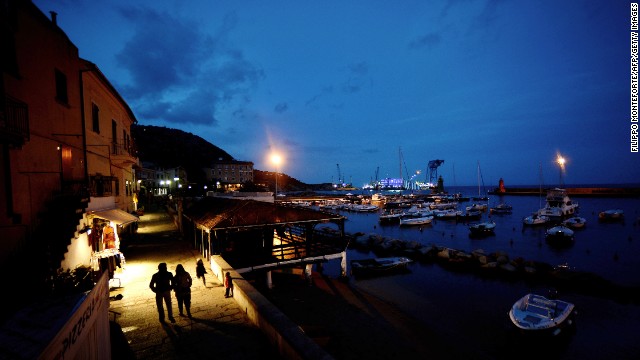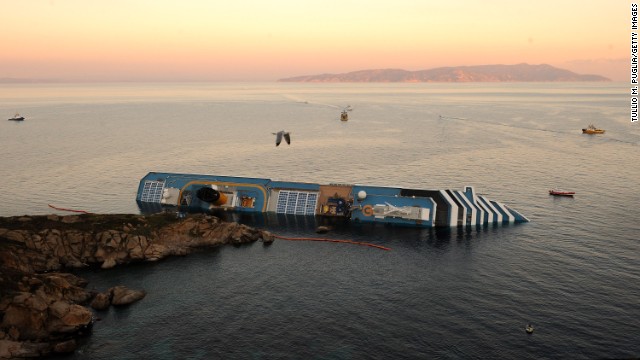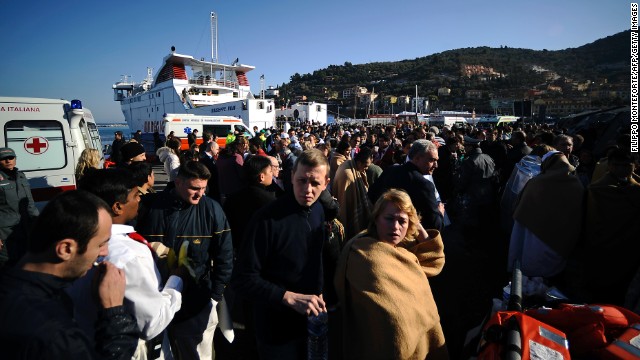Giglio, Italy - Father Lorenzo Pasquotti keeps hundreds of cards and
letters from the passengers and crew members who survived the wreck of the Costa Concordia cruise
liner on a shelf in
the rectory of the brick-faced Church of the Madonna of Giglio, just up the
narrow street from the island's only port.
Many
of the letters, handwritten in English, German, French and Italian, are
addressed simply to "Giglio, Italy 58012" to no one in particular,
almost as if the island itself is a person. The writers express gratitude for
assistance they received or apologize for the wreck's impact on Giglio.
When
the postal carrier brings the mail over on the morning ferry from the Italian
mainland, he either leaves the new letters with Mayor Sergio Ortelli or at the
church with Father Pasquotti. After all, Giglio has always been the type of
place where the mailman knows exactly who is around and who is not.
At
least that's the way it used to be before the Costa Concordia ran aground off
Giglio on January 13, 2012, killing 32 passengers and injuring dozens more. But
in the last year since the salvage operation began at full tilt, the island has
shifted from being a secluded utopia that attracted mainly birdwatchers hoping
to spot Corsican seagulls, kestrals and goldcrests, or hikers who wanted to
climb its solitary slopes, to what it is now: the epicenter of the largest-ever
maritime salvage operation in the world.
The
island has a winter population of around 1,000 people spread between the port,
the village of Castello on top of the island's hill, and the seaside village of
Campese on the other side. The population swells considerably during the summer
months when hotels and seaside resorts are brimming with sun seekers.
But
now Giglio's permanent population has been bolstered by a constant crew of at
least 500 Titan Salvage and Micoperi workers from 21 nations who have, in many
ways, invaded paradise. Many live offshore in a floating dormitory called the
Discovery, but they all make their way to the island on a regular basis.
A
scant few of the new Giglese, as the island's inhabitants are called, are pale
engineers, who, despite being on a sunny island for more than a year, still
haven't managed a tan. They spend their time in simulated control rooms behind
computer screens, working out every potential obstacle in tipping the massive
cruise liner, which ran aground off the island in January 2012, to an upright
position.
One
such worker is Jan Walhout, a Dutch engineer who will be one of the eight
people in the control room when the Concordia is rotated upright in a delicate
procedure called "parbuckling" that is scheduled to take place in
mid-September. He lives in an apartment in the port and not on the Discovery,
but he still has seen very little of the island. That's not why he's here.
"I
am here for a job," Walhout told CNN inside a simulated control room
attached to the Bahama's Hotel next to Pasquotti's church. "I know a lot
of people on the team who socialize in town, but I am here to concentrate on
this job."
The
rest of the temporary crew are mostly contracted shift workers who learned
their perilous trade in places like west Texas and the British midlands.
Salvage jobs are a natural leap for skilled deep-sea drillers and rig
constructors looking for lucrative seasonal work, and many of them have taken
up with the local girls, completely transforming the social scene at the port.
On
any given night of the week, the portside bars are filled with men in gray
Titan Salvage jumpsuits. An occasional salvage woman joins the mix, but the
vast majority are men who come in to port to unwind. Some wear holsters with
scissors hanging on them -- a cowboy-esque equivalent of a pistol for deep sea
oilrig divers. Others sling their red inflatable Titan-Micoperi life vests over
their shoulders or dangle them on the barstools.
People
are still talking about the night last June when a life vest inflated
spontaneously inside the Bar Monti, one of the most popular hangouts for the
salvage crew. Matteo Di Mariuz, who runs the popular hangout, doesn't mind the
new clientele. Sure he has had to introduce country music and imported beer for
the new crowds, but he takes it all in stride. "They are hard workers who
work long hours to move that monster from our waters," he told CNN.
"They deserve a little down time."
Mariuz,
who took over the bar from his parents two years ago, now stays open during the
winter weeknights, something his parents could rarely afford to do because
Giglio just didn't produce enough customers. In the morning he, like most of
the coffee bars along the port, will serve up American breakfast on request.
They've also learned what it takes to make a good cup of tea.
All
along the port, cafes and bakeries have adapted to the newcomers, some even
mastering the art of making BLT's and sarnies for the workers' packed lunches.
And even after the Concordia is rotated, the crews will have a lot of work to
do to fix the starboard side and refloat the ship sometime next summer, meaning
Giglio won't be going to normal any time soon.
Most
of the restaurateurs and business owners across the island hold nothing against
the salvage crews who they feel are the only hope for getting rid of the
rotting vessel. Despite an obvious decline in tourism, there is a definite
increase in steady customers, especially during the winter months when, prior
to the shipwreck, Giglio was a ghost island.
Franca
Melis, who owns a small enoteca called La Galera in Castello on the top of the
island's hill and a dive shop down in the port, says it is hypocritical for
islanders to complain that the Concordia has ruined their livelihood --
especially in the port. The economic slump surely has as much to do with a drop
in tourists, and anyway, even in good years people were never able to rent
their properties year round like they do now to the salvage workers. She even
sees a silver lining. She is lobbying other islanders to push to keep the
massive platforms Titan-Micoperi installed to stabilize the ship even after the
Concordia is towed away.
"It
would give us one of the best dive schools in the world," she told CNN.
"We can't rewind the clock and pretend none of this happened, instead we
have to look at ways to make it work for the island's vitality."
Melis
has been a strong voice both to the media and at the islanders' monthly
meetings with the salvage managers, environmental experts and Franco Gabrielli,
the government's commissioner for the Costa Concordia disaster.
She agrees that
now, when the removal of the ship is a top priority, may not be the best time
to bring up life post-Concordia, but she wants people to start thinking about
the future again. Plus, she points out that it could take up to two more years
for workers to remove all the salvage implements they've put in place, all the
while the port views will be marred with cranes and rigs. "Leave
them," she says. "They offer far more good than harm."
The
tragedy has not exactly united the islanders. In some ways, it has created two
camps -- those that see an economic advantage to the twist of fate and those
who count the days until every trace of the ship is gone. It is not difficult
to envision tense days ahead.
Melis's
main opposition to keeping the platforms is the island's headstrong mayor
Sergio Ortelli, who wants Costa Crociere to keep its promise to return his
island to exactly the way it was before anyone had ever heard of the Costa
Concordia -- and that means both above and below the waterline.
Ortelli
has a perfect view of the operation from his office window in the port and
high-resolution diagrams of every stage of the parbuckling project on his
computer, which he is happy to show on an overhead monitor to anyone who asks.
He keeps track of the salvage schedule, logging days they've lost to bad
weather to make his own estimate about when the ship will finally be gone from
his view.
"We
need our island back exactly way it was before that terrible day," he
says. He still recalls how many passengers slept in his office that fateful
night, and he says he feels a personal responsibility to the islanders to hold
Costa to its promise. "Everything must go," he says. "Not just
the ship."
No
matter what happens after the physical remains of the liner are gone, the
islanders will never forget how their lives changed the night of Friday, the
13th of January, 2012, when 4,200 people spilled into their quiet port.
Father
Pasquotti estimates that more than a thousand of the Concordia's passengers
have come back to Giglio since the accident. Many came to bring back the
blankets and dry clothing that the islanders gave them the night of the
disaster. Merchants along the port's main street usually know what belongs to
whom by asking around. Giglio still has the feel of a small town.
In
some ways everything has changed on Giglio, but a few things still remain
exactly the same. Despite having one of the most technologically advanced
salvage operations every attempted happening in the harbor, it is still
impossible to buy an iPhone charger or camera battery anywhere on the island,
or read the day's newspapers until the 9:00 a.m. ferry docks -- if someone
remembers to send them over from the mainland. No one is ever in a particular
hurry and the weather and food are just as wonderful as they were before the
Concordia came to shore.
CLICK THE VIDEO BELOW TO WATCH THE STORY





























No comments:
Post a Comment